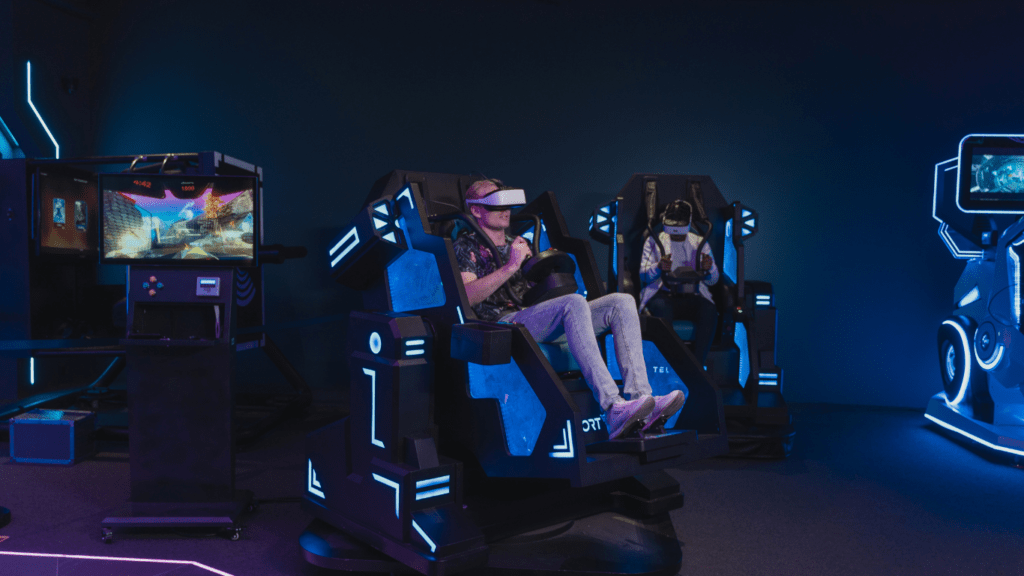Stepping into a virtual world where the boundaries of reality blur and imagination comes to life is a thrill that gaming enthusiasts are experiencing like never before. As a passionate gamer, I’ve witnessed firsthand how Virtual Reality (VR) technology is reshaping the way we play and interact in the gaming universe. The immersive nature of VR transports players into a realm where they are not just controlling a character on a screen but embodying it in a way that elevates the entire gaming experience.
In this article, I delve into the transformative impact of VR on gaming, exploring how this cutting-edge technology is revolutionizing the way we engage with virtual environments. From realistic simulations to interactive storytelling, VR is unlocking new dimensions of gameplay that were once unimaginable. Join me as we navigate through the exciting world of VR gaming and uncover the endless possibilities it brings to the table.
The Evolution of Gaming and the Rise of VR
I’ve witnessed the fascinating journey of gaming from the arcade era to the console revolution, but nothing compares to the game-changing innovation brought by Virtual Reality (VR). Let’s delve into how VR has taken gaming to a whole new level.
From Arcade to Console
I’ve seen gaming evolve from the classic arcade cabinets of the past to the powerful consoles of today. Arcade games used to captivate players with their simplistic yet addictive gameplay, drawing crowds to dimly lit arcades filled with the sounds of buttons being mashed and joysticks being maneuvered. However, as consoles like the Atari, Nintendo, Sega Genesis, and PlayStation entered the scene, gaming shifted from public spaces to living rooms, allowing players to enjoy immersive experiences from the comfort of their homes.
The Advent of Virtual Reality
I’ve always been intrigued by technology, but Virtual Reality (VR) marked a turning point in how I perceive and interact with games. The advent of VR introduced a new era of gaming where players aren’t just controlling characters on a screen; they’re stepping into fully immersive virtual worlds. With VR headsets like the Oculus Rift, HTC Vive, and PlayStation VR, gamers can explore fantastical realms, engage in heart-pounding adventures, and interact with digital environments in ways previously unimaginable. The sensory immersion offered by VR technology has blurred the lines between reality and the virtual realm, creating an unparalleled gaming experience that truly transports players to another dimension.
Key Technologies Driving VR in Gaming
- VR Headsets and Immersive Displays
When it comes to Virtual Reality gaming, one of the key technologies driving the immersive experience is the advancement in VR headsets and displays. These devices transport me to a virtual world where I can see, hear, and interact with the environment as if I’m truly within the game. Innovations such as the Oculus Rift and HTC Vive have revolutionized gaming by offering high-resolution displays and integrated audio systems that enhance realism, making every detail come to life right in front of my eyes. - Motion Tracking and Controls
Motion tracking and controls play a crucial role in enhancing the interactivity and immersion in VR gaming. By tracking my movements and gestures with precision, these technologies allow me to interact naturally with the virtual world. Whether I’m swinging a virtual sword, picking up objects, or dodging obstacles, the responsive motion tracking system ensures that my actions are accurately translated into the game, providing a seamless and intuitive gaming experience that blurs the boundaries between the physical and virtual realms.
How VR Enhances Gaming Genres

In the realm of gaming genres, Virtual Reality (VR) technology brings a new dimension to the player experience, elevating immersion and interaction to unprecedented levels. Let’s explore how VR enhances specific gaming genres:
Adventure and RPG Games
In the world of Adventure and Role-Playing Games (RPGs), VR technology revolutionizes the way players engage with virtual worlds. By donning a VR headset, I’m transported into rich, fantastical realms where every action feels real. Whether I’m exploring mysterious dungeons, casting spells, or engaging in epic battles, VR enhances the sense of presence and allows me to truly inhabit the game environment. The realistic graphics and immersive audio create a sensory experience that blurs the line between the physical and virtual worlds, making every quest and adventure feel exhilarating and lifelike.
Sports and Racing Games
When it comes to Sports and Racing Games, VR technology takes the adrenaline rush to a whole new level. As I step into the virtual arena or sit behind the wheel of a high-speed race car, the sensation of speed, competition, and skill becomes palpable. With VR, I feel like I’m actually playing the sport or driving the car, thanks to realistic motion tracking and responsive controls. The added dimension of depth perception and spatial awareness enhances my gameplay, whether I’m scoring goals on the soccer field or maneuvering tight turns on the racetrack. VR brings a heightened sense of realism and excitement to sports and racing games, making each match or race an electrifying experience.
By leveraging VR technology, gaming genres like Adventure and RPGs as well as Sports and Racing Games are transformed into immersive, interactive experiences that redefine how we play and engage with virtual worlds.
The Social Impact of VR Gaming
Exploring the social impact of VR gaming, I’ll delve into how this technology has brought about a significant transformation in the gaming world, creating new avenues for building global communities and enhancing accessibility in gaming.
Building Global Communities
In the realm of VR gaming, I’ve witnessed a remarkable trend towards the development of global communities. Through multiplayer VR games, players from diverse geographical locations have the opportunity to connect and engage in virtual spaces, fostering a sense of camaraderie and shared experiences. These immersive environments transcend physical boundaries, uniting individuals with a common passion for gaming. The collaborative nature of VR gaming experiences promotes interaction, cooperation, and the formation of lasting friendships across borders. Virtual reality has redefined the concept of social gaming, offering a platform for players worldwide to come together, collaborate, and compete in a shared virtual universe.
Enhanced Accessibility in Gaming
In my exploration of VR gaming’s impact, I’ve observed a significant improvement in accessibility within the gaming industry. Virtual reality technology has broken barriers for individuals with physical limitations, providing an inclusive gaming experience for all players. By immersing users in virtual worlds through VR headsets, developers have created a more inclusive environment where individuals of varying abilities can participate and enjoy gaming without constraints. The enhanced accessibility offered by VR gaming extends beyond physical limitations to include individuals with diverse needs, preferences, and backgrounds, opening up new possibilities for a broader audience to engage in interactive and immersive gaming experiences.
Challenges and Future Prospects
As I delve into the challenges and future prospects of VR in gaming, it’s essential to recognize the technical limitations that developers and players may encounter. Additionally, looking ahead, understanding the anticipated trends in VR gaming can provide insights into the exciting advancements awaiting players in the future.
Technical Limitations
In the realm of VR gaming, technical limitations pose obstacles that developers continuously strive to overcome. Issues such as motion sickness, limited field of view, and hardware requirements can impact the overall user experience. While advancements in technology have mitigated some of these challenges, ensuring seamless gameplay remains a priority for developers. Through innovative solutions and ongoing research, the industry aims to address these technical constraints to enhance player immersion and enjoyment further.
Future Trends in VR Gaming
The future of VR gaming holds promising trends that are poised to revolutionize the gaming experience. From the integration of haptic feedback to enhance sensory immersion to the development of more compact and user-friendly VR devices, the industry is evolving rapidly. Cross-platform compatibility and the rise of cloud-based gaming services are anticipated to expand the accessibility of VR games to a broader audience. Moreover, the fusion of VR with artificial intelligence and machine learning opens up new avenues for dynamic and personalized gaming experiences. As technology advances, virtual worlds are set to become even more realistic and interactive, offering players unparalleled levels of engagement and enjoyment.



